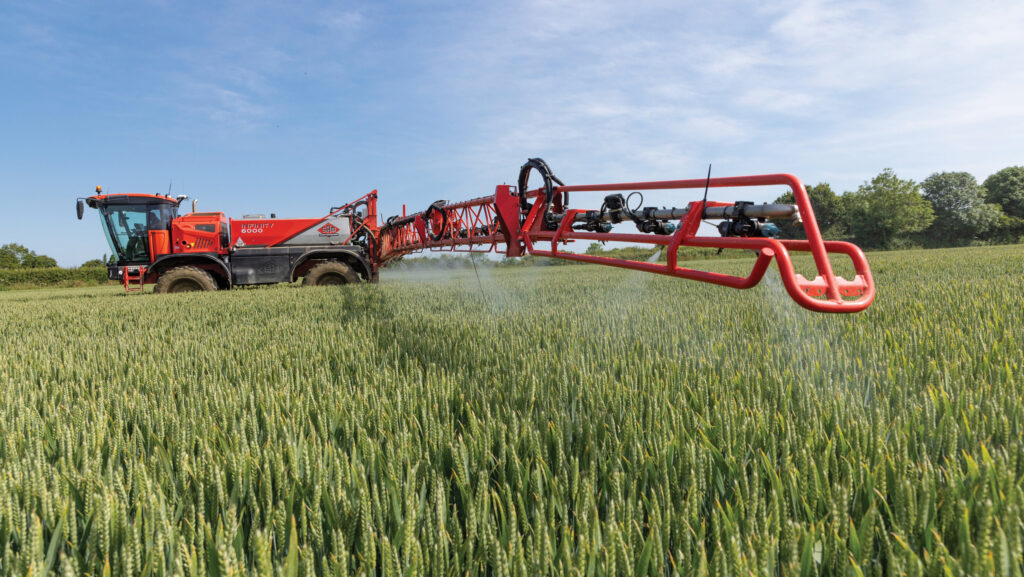How research is improving bioproduct performance
 © GNP
© GNP While the global biological crop protection industry continues to grow, with some analysts forecasting it will double in value to £21.6bn by 2028, adoption remains challenging on-farm due to a combination of inconsistent performance and it being trickier for farmers to use.
But at the recent World AgriTech Innovation Summit in London there were some positive signs that some of the technical challenges involved with creating successful biological products are being addressed.
See also: Potato cyst nematode: Measures being considered in Scotland
Shelf-life problem
For example, a major issue with many biological products is shelf life. Often products may have only a relatively short shelf life where activity is maintained, or they need storing in conditions that are difficult for farmers and others in the supply chain to achieve.
Austrian firm Ensemo is developing technology that will help improve the shelf life of microbes applied to seeds.
Doris Gusenbauer, business development manager for Ensemo, explains that instead of applying microbes to the seed surface, where external environmental factors potentially reduce efficacy quickly, the firm injects micro-organisms into the seed, where they are better protected.

Ensemo team, with Doris Gusenbauer (right) © Mike Abram
Modular, transportable machines separate seeds before mechanically cutting them without harming the embryo, injecting microbes or their metabolites into the cut, and then sealing the cut with a biopolymer.
“We can do this at industrial scale with high throughput of thousands of seeds a second,” Doris says.
The initial product is for the treatment of soya with rhizobia, with the technology’s efficiency and efficacy proven in lab tests, greenhouse trials and in the field, as well as industrial settings with global seed producing companies. Maize is likely to be the next crop treated.
“We prolong the shelf life of soya seeds treated with rhizobia,” Doris says.
“In trials, we have as good efficacy after six months storage as we do on day one. In comparison with seed coatings, there is a strong decline after four weeks.”
Different approach
Belgian start-up BiocSol, a spin-off from UCLouvain, is also taking a different approach to developing biological solutions.
Co-founder and chief technical officer Simon Caulier says that instead of trying to formulate microbes to apply directly, with the issues around efficacy, storage and impact on biodiversity, BiocSol is looking to deliver the substance that makes the microbe active against a disease.
“It seems more logical to work with what the microbes are producing to help control diseases,” he explains.
Starting with more than 4,000 candidate microbes and screening them against various pathogens, BiocSol has narrowed down its evaluation to natural substances produced by microbes that control late and early blight in potatoes and downy mildew in grapevines, lettuce and salad leaves.

Simon Caulier from BiocSol © Mike Abram
“We have field trials conducted by Wageningen University showing proof of concept,” Simon says.
While control levels achieved by the biofungicides are not as good against blight as synthetic systemic pesticides, he says that depending on the severity of disease, it’s possible to achieve good protection.
“The aim is to produce biofungicides that are compatible with the use of other organic fungicides or conventional products to decrease the total amount of chemicals used in the field.”
UK work
Norwich-based PfBIO is also developing biofungicides, initially for control of powdery mildew, botrytis and crown rot in berries.
Other projects are investigating diseases in potatoes, onions, tomatoes, hops and lavender.
It’s Mara (multi-active, robust microbial antifungals) range of products is based on microbial strains sampled from farmland and surrounding environments, or direct from situations where the pathogens are active, says PfBIO chief executive Dr Rosaria Campilongo.
Various techniques are used to screen the bacteria, including genome sequencing and bioinformatics, as well as microbiological and phenotypical assays.
“We want to understand what makes the bacteria active. To do so, we use genetic tools to delete specific genes to check whether those genes were responsible for the activity,” Rosaria explains.
“We also check how the bacteria survive on plants, not least because that gives an idea of how often you need to apply the products to crops, and also efficacy.”
Formulation is a key factor in making a viable product, with PfBIO investigating both liquid and solid formulations. “Powder formulations, assuming you can re-solubilise, are useful for storing products for longer,” she says.
The firm’s initial basic formulation looks promising for stability in storage tests, while initial field trials with the bacterial strain in strawberries carried out this summer showed a visual difference between treated and untreated.
Biostimulant
While both BiocSol and PfBIO are unlikely to launch any commercial products until the early 2030s, potentially much closer to commercialisation is the first biostimulant product from SugaROx, a spin out of Oxford University and Rothamsted Research.
The active ingredient in the first product is a modified version of a sugar found in all plants, trehalose-6-phosphate (T6P), which stimulates carbon use and allocation.
This could be commercially available in the UK from the 2026-27 season, bringing a different type of biostimulant to the market, suggests Bianca Forte, business development director for SugaROx.
“We’re synthesising biostimulants based on very specific plant molecules, which is the complete opposite of what’s in the market currently,” she says.
“Current biostimulants are extracts from algae and plants, or acid-based formulations produced from organic waste.
“Those products are mixes of active ingredients, which makes it difficult for manufacturers to optimise their performance as there are many molecules interfering with different pathways in the plant or soil.”
In contrast, SugaROx has identified specific bottlenecks in plant physiology or biochemistry which are not optimised.
T6P, for example, controls carbon use and allocation in grain crops including wheat, increasing yields while maintaining quality. The venture is also investigating its use in other crops, such as tomatoes and strawberries.
The key technical challenge SugaROx faced is that while these compounds are naturally synthesised inside plant cells, for successful incorporation into farming practice they require adaptation for foliar application.
In its natural form, T6P carries a strong charge, which means it isn’t absorbed if sprayed onto crops, Bianca says.
“To address that, we synthesise a version with a chemical modification to allow plants to absorb it after spray application.
“A few hours after spraying, natural sunlight will cleave off the modification, releasing the T6P inside the plant cell to deliver the stimulating effect.”
Field trials
Field trials in Canada, the US, the UK, Germany and India over the past few years have shown yield benefits ranging from 4-14% in wheat crops under drought stress, and 5-22% in crops grown under good water availability.
Application timing is important, with the optimum 10 days after flowering, during grain milk development.
“There’s a window of five to 15 days after flowering when the product can be effective, but 10 days is the optimum.”
The narrow window isn’t necessarily an issue for the success of the product, Bianca insists, but she recognises the economics will need to be positive, especially in markets where farmers might not use ear sprays.
“We’re currently looking at a price point that would deliver a 1:3 return on investment for farmers, taking into account the cost of spraying.”
Further down the pipeline are other plant molecules that hijack other biochemical pathways, she adds.
“They require the same technology to allow them to be absorbed into the plant, and then the chemical modification to be cleaved off so the molecules can do their job.”
What will drive greater adoption?
Greater adoption of biological crop protection on-farm will be driven by a combination of education, quicker regulatory decisions, better investment decisions and use of generative artificial intelligence, according to Mark Brooks, managing director of FMC Ventures, the venture capital arm of FMC.
Understanding that biological crop protection works differently to synthetic chemicals – potentially slower – is an area where more education is required, he suggests.
Slow regulatory decisions are hampering the speed of innovation. “That’s got to change,” he says.
While there is no shortage of companies pitching for investment from venture capitalists, smarter decisions to invest in the right companies would help with progress, he suggests, while using the power of computing through generative AI and machine learning technology will help accelerate the process of finding new targets and products.
All those quoted were attending the World AgriTech Innovation Summit, held in London in September.
